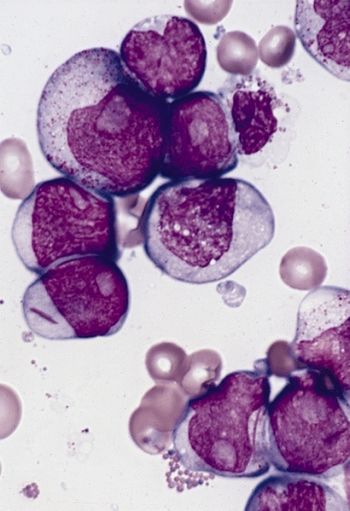 |
| BONE MARROW: ACUTE MYELOBLASTIC LEUKEMIA WITH MATURATION (AML-M2) Bone marrow smear from a patient with acute myeloblastic leukemia with maturation showing several blasts with prominent nucleoli, a promyelocyte, and a myelocyte. Two of the blasts contain prominent Auer rods. (Wright-Giemsa stain) (Photo credit: Wikipedia) |
Residential Proximity to Heavy-Traffic Roads, Benzene Exposure, and Childhood Leukemia—The GEOCAP Study, 2002–2007 (Abstract, Jennifer Houot, Fabienne Marquant, Stéphanie Goujon, Laure Faure, Cécile Honoré, Marie-Hélène Roth, Denis Hémon and Jacqueline Clavel, Am. J. Epidemiol., Sep. 15, 2015)
Also discussed here: Study of leukemias in children living close to heavily used roads. (ScienceDaily, Sep. 17, 2015)
Today we review research conducted in France with 5 years of data to explore the incidence of leukemia for children exposed to roadside emissions. Results indicate that while there is no significant link with nitrogen dioxide, there is a 30% greater frequency of myeloblastic type leukemia for children living within 150 m of heavy traffic when there is also a higher concentration of benzene in the emissions.
Key Quotes:
“With 470 new cases each year, leukemias (blood cancers) are the most common childhood cancers, and are mainly acute lymphoblastic leukemias.”
«
"The frequency of myeloblastic type leukemias was 30% higher in children living within a 150 m radius of heavily used roads, and where the combined length of road sections within this radius exceeded 260 m,"
“there was no association between acute lymphoblastic leukemias -- the most common -- and the atmospheric concentration of nitrogen dioxide, distance or combined length of heavily used roads in the vicinity of dwellings”
“the risk of childhood acute myeloblastic leukemia was double in Île-de-France children whose residences were the most exposed to traffic, i.e. when, simultaneously, the combined length of road sections within a 150 m radius of the residence exceeded 300 m, and the estimated mean annual concentration of benzene in the vicinity of the residence was above the median value observed in Île-de-France (1.3 µg/m3).”
“These results, which were free from any participation bias and based on objectively determined indices of exposure, showed an increased incidence of AML associated with heavy-traffic road density near a child's home. The results support a role for traffic-related benzene exposure in the etiology of childhood AML”







No comments:
Post a Comment